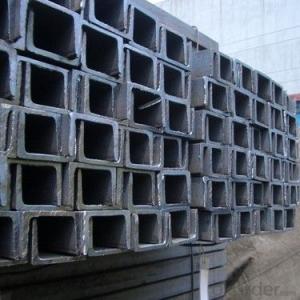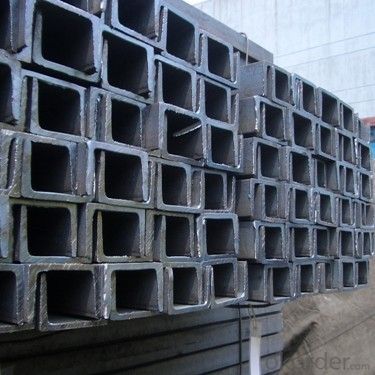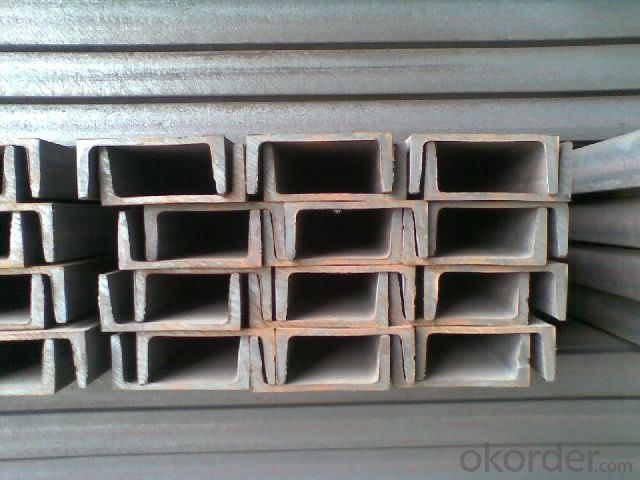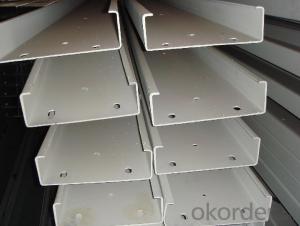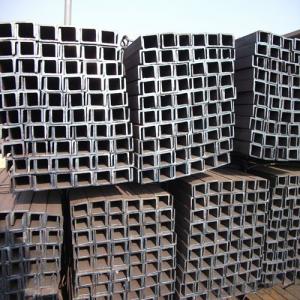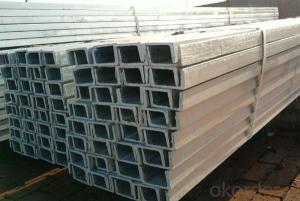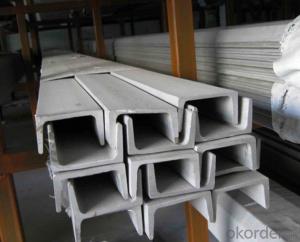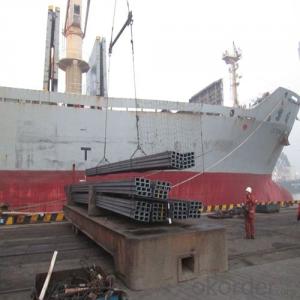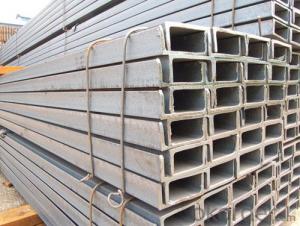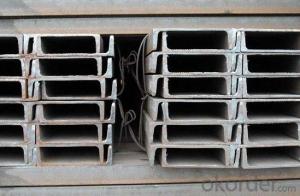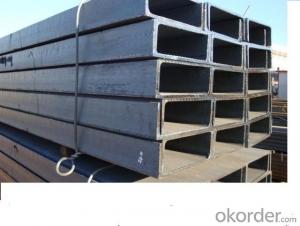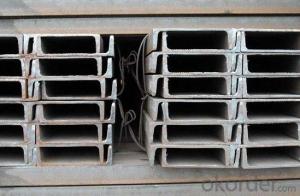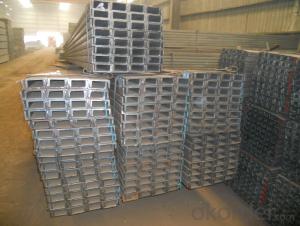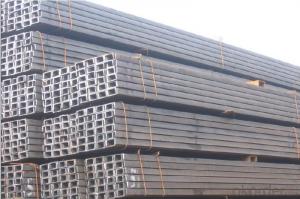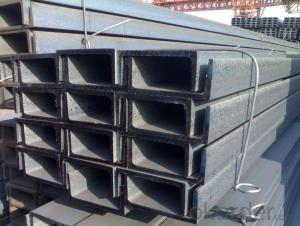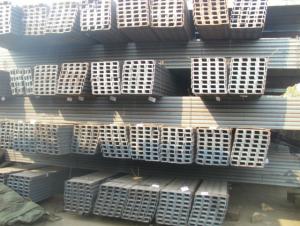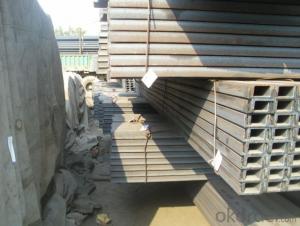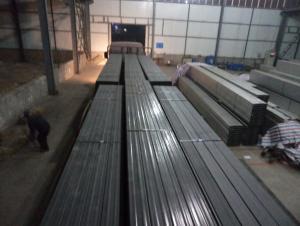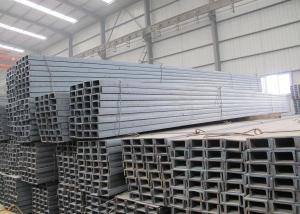GB Standard Steel Channel 140mm with High Quality
- Loading Port:
- China Main Port
- Payment Terms:
- TT or LC
- Min Order Qty:
- 25 m.t
- Supply Capability:
- 10000 m.t/month
OKorder Service Pledge
OKorder Financial Service
You Might Also Like
Product Description:
Specifications of GB Standard Steel Channel 140mm with High Quality:
1. We are definitely specializing in manufacturing and supplying channel steel.
| Standard: | GB/T 6723-86 |
| Sizes: | 140mm |
| Sales Volume/Year: | 10000MT |
| Destination Area: | Middle East, Africa, Southeast Asia |
2.Size, Length and Mass.
| Size(mm) | Length(m) | Mass(Kg/m) |
| 140*60*3 mm | 6m, 12m | 5.864 kg/m |
140*60*4 mm | 6m, 12m | 7.662 kg/m |
| 140*60*5 mm | 6m, 12m | 9.420 kg/m |
| 140*60*6 mm | 6m, 12m | 11.21 kg/m |
Package & Delivery of GB Standard Steel Channel 140mm with High Quality:
The steel u channel will be packed in bundle with steel wire at each end of every bundle and color marking in order to help the customer to recognize his goods more easily at sight.
And steel u channel could be loaded into 20ft or 40ft container, or by bulk cargo. If the weight of each bundle reaches less than 3.5 mt, the loading by break bulk cargo should be choosed. When the weight of each bundle reaches less than 3mt, the loading by container should be choosed.
As for the transportaion from mill to loading port, the truck will be usually used. And the maximum quantity for each truck is 40mt.
All in all, we could do in accordance with customer's request.
FAQ:
Q1: How soon can we receive the product after purchasement?
A1: Within three days of placing an order, we will begin production. The specific shipping date is dependent upon international and government factors, but is typically one month.
Q2: How do you guarantee the quality of our products?
A2: We have established an advanced quality management system which conducts strict quality tests at every step, from raw materials to the final product. At the same time, we provide extensive follow-up service assurances as required.
Q3: The prices are invoicing on theoritical weight or on actual weight?
A3: We can do it in both manners, according to the customers' request.
Images of GB Standard Steel Channel 140mm with High Quality:
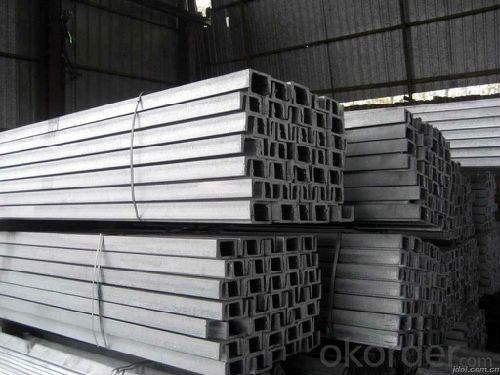
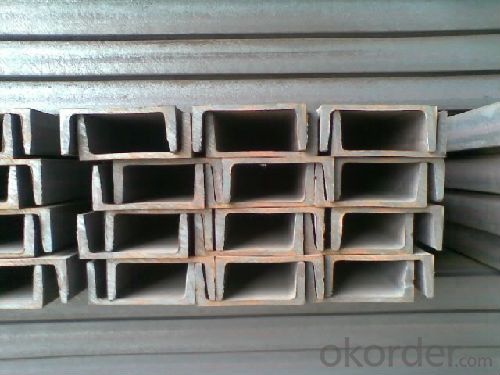
If you would like to get our price, please kindly inform us the standard/material, size and quantity. Thank you very much.
- Q: How do steel channels perform under extreme weather conditions?
- Steel channels are renowned for their exceptional performance in the face of adverse weather conditions. The inherent robustness and longevity of steel render it highly impervious to severe weather phenomena such as intense winds, torrential rains, extreme temperatures, and even earthquakes. Regarding strong winds, steel channels exhibit remarkable resilience against wind loads due to their rigidity and stability. They are engineered to endure formidable gusts without warping or bending, making them an ideal choice for areas prone to hurricanes or regions with high wind velocities. When it comes to heavy rainfall and flooding, steel channels also demonstrate exceptional reliability. They possess superior resistance to water damage and corrosion, which safeguards the structural integrity from compromise. Furthermore, steel channels can be coated or galvanized to offer an extra layer of protection against rusting and moisture infiltration. Extreme temperatures, whether scorching or frigid, do not significantly impact the performance of steel channels. Steel boasts a high melting point, rendering it impervious to heat and fire. Moreover, it retains its strength and integrity even in exceedingly low temperatures, ensuring it does not become brittle or susceptible to fractures. Lastly, steel channels have proven their resilience in earthquake-prone regions. The inherent ductility of steel allows it to flex and absorb seismic forces, thereby reducing the risk of collapse or structural damage. This is particularly critical in areas with high seismic activity, where the ability of steel channels to withstand ground shaking is of utmost importance. In conclusion, steel channels excel in extreme weather conditions due to their strength, durability, resistance to wind, water, and temperature, as well as their capacity to withstand seismic forces. Their reliability makes them the preferred choice for a wide range of applications in both residential and commercial construction, ensuring the safety and longevity of structures in challenging weather environments.
- Q: What are the factors that affect the price of steel channels?
- The price of steel channels can be influenced by various factors. Let's explore some of these factors: 1. Raw material costs play a significant role in determining the price of steel channels. The cost of materials like steel, iron ore, and coal directly affects the manufacturing cost of steel channels. Fluctuations in these raw material prices can, in turn, impact the final price of the channels. 2. Supply and demand dynamics also have an impact on steel channel prices. When demand for steel channels is high and the supply is limited, prices tend to rise. Conversely, if demand is low and there is excess supply, prices are likely to decrease. 3. Manufacturing and processing costs, including expenses related to labor, energy, and equipment, can influence the price of steel channels. Higher manufacturing costs may result in higher prices for the channels. 4. The level of competition among steel channel manufacturers can also affect prices. When multiple producers offer similar products, they may engage in price competition to attract customers, leading to lower prices. On the other hand, if there are fewer suppliers or if they offer unique products, prices may be higher. 5. Transportation and logistics costs can impact the final price of steel channels. Factors such as fuel prices, shipping distances, and transportation infrastructure all contribute to transportation costs, which can be passed on to the buyer. 6. Government regulations and tariffs are another factor that can influence steel channel prices. Trade policies, import duties, and government regulations can increase the price of imported steel channels, while subsidies or support from the government can lead to lower prices. 7. Economic conditions, both globally and domestically, have an impact on steel channel prices. Economic growth, inflation, and currency exchange rates can all influence the cost of steel channels. It is important to understand that these factors are interconnected and can vary depending on market dynamics and location. Therefore, buyers and sellers in the steel channel industry must consider these factors and their potential impact.
- Q: How do steel channels contribute to the overall daylighting of a building?
- The overall daylighting of a building is not directly influenced by steel channels. Daylighting entails utilizing natural light to illuminate the interior spaces of a building, achieved by strategically placing windows, skylights, and other transparent materials to allow natural light inside. Steel channels, on the other hand, are structural elements used in construction to provide support and stability to various building components. They are commonly found in framing systems, such as walls, floors, and roofs, to enhance strength and rigidity. Although steel channels themselves do not contribute to daylighting, they can have an indirect impact on the overall daylighting of a building. For instance, they may be utilized in constructing window frames, which help support and secure windows in place. Properly designed and installed window frames ensure that windows are positioned correctly to maximize natural light entry. Furthermore, steel channels can be employed in constructing skylights, specially designed to bring natural light from above. Skylights with steel channel frames offer structural support and stability, allowing secure installation in the roof or ceiling. In conclusion, while steel channels do not directly contribute to a building's overall daylighting, they do play a role in supporting and securing windows and skylights, crucial elements in a building's daylighting strategy.
- Q: Can steel channels be used for supporting signage and billboards?
- Yes, steel channels can be used for supporting signage and billboards. Steel channels are known for their strength and durability, making them suitable for providing structural support to hold and secure various types of signage and billboards.
- Q: What are the different methods for protecting steel channels from water intrusion?
- There are several methods for protecting steel channels from water intrusion, depending on the specific requirements and conditions. Here are some common methods: 1. Coatings: Applying a protective coating to the surface of steel channels is one of the most effective methods for preventing water intrusion. Coatings such as epoxy, polyurethane, or zinc-rich paints create a barrier that prevents water from coming into contact with the steel, thus reducing the risk of corrosion. 2. Galvanization: Galvanizing steel channels involves coating them with a layer of zinc, which acts as a sacrificial barrier against corrosion. This method is particularly effective in environments with high humidity or exposure to corrosive substances. 3. Waterproofing membranes: The application of waterproofing membranes on the surface of steel channels can prevent water from seeping into the material. These membranes can be made of various materials such as bitumen, rubber, or PVC, providing a protective barrier against water intrusion. 4. Sealants: Using sealants, such as silicone or polyurethane caulk, can effectively seal gaps or joints in steel channels, ensuring water does not penetrate these vulnerable areas. It is essential to regularly inspect and replace sealants to maintain their effectiveness. 5. Drainage systems: Installing a proper drainage system around steel channels can help divert water away from the structure. This can be achieved through the use of gutters, downspouts, and proper grading to ensure water flows away from the channels, reducing the risk of water intrusion. 6. Maintenance and inspection: Regular maintenance and inspection of steel channels are crucial for identifying any signs of water intrusion or corrosion. Promptly addressing any issues, such as repairing damaged coatings or sealants, can prevent further damage and ensure the long-term protection of the channels. It is important to note that the effectiveness of these methods may vary depending on factors such as the specific environment, exposure to water, and the quality of materials used. Consulting with professionals and adhering to industry standards and guidelines is highly recommended to ensure the most suitable method is employed for protecting steel channels from water intrusion.
- Q: How are steel channels used in the construction of hospitals or healthcare facilities?
- Steel channels are used in the construction of hospitals or healthcare facilities to provide structural support and reinforcement. They are commonly used in the framing of walls, ceilings, and floors, ensuring the stability and durability of the building. Steel channels also play a vital role in the installation of electrical and plumbing systems, as they provide a secure pathway for wiring and piping. Additionally, they are utilized for mounting equipment, such as medical gas lines or HVAC units, ensuring efficient operation and maintenance of the facility.
- Q: Can steel channels be used for supporting rooftop gardens?
- Yes, steel channels can be used for supporting rooftop gardens. Steel channels are strong and durable, making them suitable for providing structural support to rooftop gardens and their associated weight. Additionally, steel channels can be customized to meet specific design requirements, providing flexibility in creating a stable and secure framework for rooftop gardens.
- Q: What are the different types of steel channel connections for column framing?
- There are several types of steel channel connections used for column framing, including welded connections, bolted connections, and pinned connections. Welded connections involve welding the steel channels together to create a strong and rigid joint. Bolted connections use bolts and nuts to secure the channels together, allowing for easier assembly and disassembly. Pinned connections utilize pins or dowels to connect the channels, providing flexibility and allowing for relative movement between the connected members.
- Q: How about the moment of inertia of two back to back channels? There is no formula,,,,.
- Two people can add. Two moments of inertia are added together.
- Q: Can steel channels be used for roofing applications?
- No, steel channels are not typically used for roofing applications. Roofing materials such as shingles, tiles, or metal sheets are more commonly used for this purpose.
Send your message to us
GB Standard Steel Channel 140mm with High Quality
- Loading Port:
- China Main Port
- Payment Terms:
- TT or LC
- Min Order Qty:
- 25 m.t
- Supply Capability:
- 10000 m.t/month
OKorder Service Pledge
OKorder Financial Service
Similar products
Hot products
Hot Searches
Related keywords
